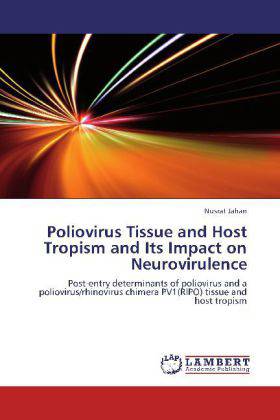
- Afhalen na 1 uur in een winkel met voorraad
- Gratis thuislevering in België vanaf € 30
- Ruim aanbod met 7 miljoen producten
- Afhalen na 1 uur in een winkel met voorraad
- Gratis thuislevering in België vanaf € 30
- Ruim aanbod met 7 miljoen producten
Zoeken
Poliovirus Tissue and Host Tropism and Its Impact on Neurovirulence
Post-entry determinants of poliovirus and a poliovirus/rhinovirus chimera PV1(RIPO) tissue and host tropism
Nusrat Jahan
Paperback | Engels
€ 89,45
+ 178 punten
Omschrijving
Using two different approaches, light was shed on the role of some of post-entry determinants in the PV tissue-host tropism. In the first approach, a chimeric virus PV1(RIPO), utilizing the cognate IRES of human rhinovirus type 2 (HRV2) was used to study the potential contribution of the IRES element toward the cell tropism. Experiments were performed to shed light on the mechanism by which this variant expresses its remarkably attenuated phenotype in poliovirus-sensitive CD155 transgenic (tg) mice. The second approach was designed to study the PV tropism in a cell line known as MDCKCD155 , which is a first known example of CD155 expressing mammalian cell line that cannot be infected by wild type PV. The results indicate that once the virus is inside the cell, the IRES driven translation of viral RNA is fully functional but the cells either fail to support or actively prevent the viral RNA replication resulting in nonproductive infection. This work demonstrates that poliovirus tissue and host tropism is also governed at a stage after the entry of the viral RNA in the cells either at the translational level or at the replication level of viral RNA.
Specificaties
Betrokkenen
- Auteur(s):
- Uitgeverij:
Inhoud
- Aantal bladzijden:
- 200
- Taal:
- Engels
Eigenschappen
- Productcode (EAN):
- 9783848423491
- Verschijningsdatum:
- 26/04/2012
- Uitvoering:
- Paperback
- Afmetingen:
- 152 mm x 220 mm
- Gewicht:
- 299 g

Alleen bij Standaard Boekhandel
+ 178 punten op je klantenkaart van Standaard Boekhandel
Beoordelingen
We publiceren alleen reviews die voldoen aan de voorwaarden voor reviews. Bekijk onze voorwaarden voor reviews.








